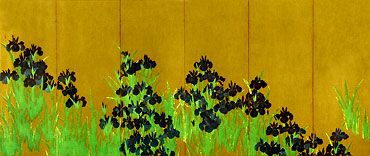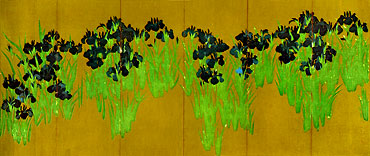|
|
|
Perhaps the most popular-almost overfamiliar-design
in all of Japanese art is Korin's panorama of iris flowers spreading across
two golden screens. In ensemble and in detail this work has been reproduced
as frequently and abundantly as, shall we say, Botticelli's Primavera. And
perhaps for the same reasons: the same eternal appeal of rebirth in spring
and the same unfailing delight elicited by a painter's perfect assurance
in translating a force of nature into his own pictorial terms. Excessive
repetition may sometimes dull one's appreciation, just as one may feel an
excess of spring itself in the fullness of a lavish month of May. But a
few months later one is once more enchanted with the prospect of a new spring,
with another glimpse of the Primavera, with another encounter with those
myriad purple blossoms rising from a golden river . |
|
|
|
| |
| The exact date of the creation of the
iris screens has never been established, although it is usually placed around
1705. But a date is hardly needed, for one feels certain that this work
is a climax in the artist's development. It is the sort of work that can
be planned and executed only when a painter is so strong, so unhesitantly
assured, that he is able to pick up his brushes almost nonchalantly and
toss off a masterpiece that appears organically right, easy, flawless, and
unrestrained. Korin almost persuades us that he did nothing more than eavesdrop
on nature's own processes and whisk one of her fragments directly onto his
screens. |
|
| |
| In his last years, between 1705 and
1716, Korin was able to do just that. Into these culminating years of a
master's high maturity we must place this work that goes beyond even the
Red and White Plum Blossoms in its reductio ad ultimum. UntiI the present
owner brought this pair of screens to Tokyo in 1913, they were the property
of the Nishi Hongan-ji in Kyoto, and very Iikely they had been painted for
that same temple, which holds as much importance in the Iife of Korin as
the Daigo-ji did in the Iife of Sotatsu. We know that Korin often visited
the Nishi Hongan-ji and valued his connection with the abbot. |
|
| |
| The theme of irises growing along a
stream was derived from an ancient poem, in the characteristic literary
and painterly "renaissance" way of the Koetsu- Korin schooI. Korin undoubtedly
had in mind the "Yatsuhashi" poem from the "Azuma-kudari" chapter of the
Ise Monogatari, that inexhaustible romance of the tenth century which had
also occupied so large a share of Sotatsu's thoughts. The tale that became
a favorite subject for Korin's design recounts how the poet Narihira and
his companions on a long journey stopped to rest at Mikawa (in the present
Shizuoka Prefecture) beside a river bank abloom with irises. An old rustic
bridge of eight wooden planks reminded the weary travelers of a similar
spot in Kyoto, for which they expressed their yearning in a series of nostalgic
verses. Their sadness did not prevent them from turning their poetizing
into a game with a set rule that each line begin with a syllable from the
word for iris: kakitsubata. Here is Narihira's poem, with a translation
by Frits Vos: |
| |
| |
| Karagoromo |
As I have got a wife |
| Kitsutsu nare ni
shi |
To whom I have been
attached, |
| Tsuma
shi areba |
Just as
one gets used to and fond of |
| Harubaru
kinoru |
The skirt
of a beautiful garment |
| Tabi
o shi zo omou. |
While
wearing it-
I feel miserable about this very joumey
On which I have come so far. |
|
| |
| |
| The eight-plank bridge and the iris
flowers appeared often in paintings, ceramics, lacquer ware, fans, and other
artistic products of the Korin school. For his large interpretation on full-size
screens Korin selected the simplest statement, leaving out bridge and stream,
omitting such decorative accessories as lacquer and mother-of-pearl, and
confining himself entirely to the flowers against an abstract golden area.
He even left out his favorite device of ripping waves. Nothing but a streak
of purple flowers and green pointed leaves against the small shimmering
squares of gold foil that represent river and air and sky. |
| |
| Korin was an artist of so many facets
that no single work can contain them all, but Irises comes close to such
a summation. Typical is its start in literature and its termination in decorative
refinement. This range, which was also characteristic of the Koetsu-Sotatsu
interest, was pressed by Korin to the ultimate degree. Sotatsu had been
content to halt at a dramatic climax, where decorative considerations sustained
the literary stimulus yet remained subservient to the poetic or imaginative
ingredients. Korin relaxed the poetic thread and tightened the decorative
one. Perhaps one may forget that his iris flowers had their seed in the
Ise Monogatari and accept them directly for their flamboyant splendor of
color and their acute space relationships. In this regard Korin is more
"modern" than Sotatsu. He could almost qualify as a twentieth-century abstract
painter-almost as a forerunner of Matisse. This is stated neither in praise
not in blame but as a matter-of-fact recognition of their similarity in
aesthetic approach. |
| |
| |
| |
|
All images and information from
The Art of the Japanese Screen by
Elise Grilli.
Walker/Weatherhill, New York & Tokyo.
1970. .
|



